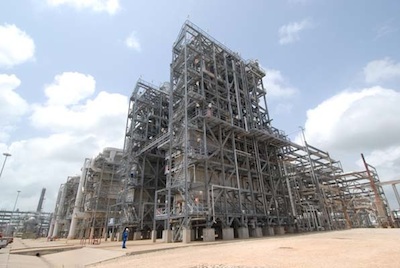Dow Chemical production plant in Freeport, Texas. The company plans to build an new ethylene production plant in Freeport by 2017. Credit: Dow Chemical Co.
Last week I told you about the extremely harsh environments in reverse-flow pyrolysis reactors and how “ceramic dusting” can be brought on by high process temperatures combined with cycling between oxidizing and reducing atmospheres. The authors of the papers I reported on are interested in finding more efficient ways of making ethylene. In the post, I stuck to the science, partly because I really did not know how big the ethylene business is. That gap in my knowledge was rectified last week when I came across a blog post in Technology Review that shed some light on the business drivers behind the research.
My first clue was that ExxonMobil sponsored the research that generated the papers, so I figured that ethylene was a Big Business. And it is—to the tune of a $148 billion market, which makes it the world’s highest-volume chemical. It is used to make all things plastic—bottles, toys, clothes, carpet, tires, grocery bags, anti-freeze, etc. The pop entertainer Madonna famously sang that she was a “material girl living in a material world,” but arguably, she is living in an ethylene world.
Ethylene is made from ethane, a component found in natural gas in amounts of about 1-6 percent by volume. Ethane is also a byproduct of the petroleum refining process. Thus, steam cracking plants tend to be built near natural gas fields or refineries.
The drop in natural gas prices over the last 18 months, driven in part by shale gas production, is prompting companies to reinvest in domestic chemical producing plants overall, and in ethylene plants in particular. The article points to Dow Chemical’s plans to spend $4 billion to expand its production capacity, including a new ethylene-producing plant that is to open in 2017 in Freeport, Texas. Also, on a timeline that coincides with the drop in natural gas prices, the article says, “Over the last two years, manufacturers have announced plans to add 10 million metric tons of ethylene capacity in the United States by 2019.”
According to the article, it costs $300 to make a ton of ethylene. Costs are higher elsewhere: $1,717 in Asia (reflecting a dependence on pricey oil for ethane) and $455 in Saudi Arabia (based on ethane and butane sources). One half of the bet that companies like Dow Chemical are making is that natural gas prices will stay low, but I’ve heard from informal sources that shale production is expected to have only a 40-50 year run. A recent article in the Columbus Dispatch confirms the 40-year horizon, but warns that this is the estimate provided by operators (also the source of my anecdotal information), but that the average lifetime of a shale-gas well may be more like 5-7 years. Last fall, a New York Times article reported on the shaky underpinnings of the natural gas glut. Plus, the industry is still working to make the case on the local level that it is a safe and environmentally responsible technology. In other words, availability of cheap natural gas is an unsure bet for the long term.
In the face of the uncertain economics of cheap sources of ethane, the mitigating bet is to engineer cracking technology to its maximum efficiency. Research and development almost by definition has a long-term payoff horizon, but with numbers this big, pushing a process from 30 percent to 70 percent efficiency, is a mighty big payoff, even if it takes awhile to realize. And, it looks like engineered ceramics could be key enablers of the next-generation cracking technology.

